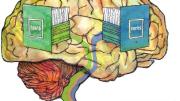Imagine the brain as a giant filing cabinet. The puzzle of deciphering the labels on the drawers has occupied many a scientist and philosopher, all the way back to Plato, who theorized in his dialogue Cratylus that human speech is made up of nouns and verbs that are, in turn, made up of letters and sounds.
The noun-verb divide is a common theoretical motif, and now Kevin Shapiro ’00, an M.D.-Ph.D. candidate in medicine and psychology, has found hard evidence that nouns and verbs do indeed occupy different drawers. By using magnetic resonance imaging (MRI) to track oxygenated blood flow in the brains of his test subjects, Shapiro isolated one area that became active only during tasks involving nouns, three areas that lit up only during tasks involving verbs, and several areas that responded to both.
Although he warns that questions remain about when and why the brain developed in this way, Shapiro points out that the activity shows up in intriguing places. One of the “verb spots,” for instance, is in the left frontal lobe, adjacent to the so-called motor strip (precentral gyrus), which contains the neurons that generate movement throughout the body; the adjacent area is involved with planning motion. (In the brain, each bulge in the gray matter is called a gyrus; each crevice that divides two bulges is a sulcus.)
Shapiro had already amassed some evidence for the “drawers” theory. In an earlier study, he found that when he used a magnetic current to interrupt brain activity in the left frontal lobe temporarily, his subjects were slower at completing sentences with verbs, as compared to those with nounssuggesting he had found a “verb area.” This finding held even when the assignment was to conjugate a made-up verb (“he wugs”/“they wug”). “We thought that was pretty good evidence that they’re not actually retrieving stored meanings of words,” says Shapiro, “that it’s something to do with grammatical function that’s being represented, at least in that part of the brain.”
In the recent study, Shapiro used 10 subjects, five of each sex. All were right-handed adults, from 19 to 25 years old, native speakers of English who had at least 14 years of education and no history of neurological or psychiatric illness. There were also 18 controls who performed the same tasks without MRI scanning. Shapiro showed each subject a two-word phrase and then provided a different cue word, asking the subject to fill in the blank by saying aloud what should come next. In a task involving nouns, the subject might see “One pond,” followed by “Many ________,” with “ponds” as the correct answer. The study also included verb tasks with cues such as, “He weeps,” “They _______.”
Meanwhile, Shapiro was monitoring activity in the subjects’ brains using fMRI, or functional magnetic resonance imaging, a technique that observes change over time, to compare oxygenated blood flow patterns in successive images. (Assisting him with the study’s design were instructor in neurology Lauren Moo, an fMRI expert from Massachusetts General Hospital, and Starch professor of psychology Alfonso Caramazza, who directs Harvard’s Cognitive Neuropsychology Laboratory.) Surprisingly, the response times for tasks using concrete words (saying “many wagons,” after seeing “one wagon”) were actually longer than for tasks using more abstract words (saying “many sounds” after seeing “one sound”)1.8 percent longer with nouns and 3.8 percent longer with verbs.
In general, Shapiro’s findingspublished in the Proceedings of the National Academy of Sciencessquare with previous research. Thus, one region that becomes active with both nouns and verbs is Broca’s area, long known to be essential to language. (Pierre Paul Broca, a nineteenth-century French neurosurgeon, treated a patient who understood speech perfectly, as evidenced by his ability to follow directions, but whose vocabulary was limited to one word, tan. After the patient died, Broca conducted an autopsy and observed damage to a spot near the bottom of the left frontal lobe.)
Another area activated by both noun and verb tasks is the left superior temporal gyrus, which became active whenever a subject was performing a comparatively difficult task, such as conjugating an irregular verb. Shapiro posits that human brains may have a “difficulty area” that fills in when the other language areas can’t quite get the job done.
The association of brain regions with specific tasks and traits has its roots in phrenology, a pseudoscience that was all the rage during the Victorian era. Phrenology held that one could evaluate someone’s intelligence, honesty, and general character based on the shape of his or her skull. Notwithstanding those false assumptions, science still credits phrenology with pioneering the notion that functions could be localized within the brain. Today, despite fMRI’s widespread use, much of the brain remains an unmapped landscape. Shapiro’s next frontier will be a similar study with bilingual Spanish-English speakers. He hopes to learn whether Spanish verbs and English verbs share a drawer.
~Elizabeth Gudrais
Kevin Shapiro e-mail address: kshapiro@fas.harvard.edu






